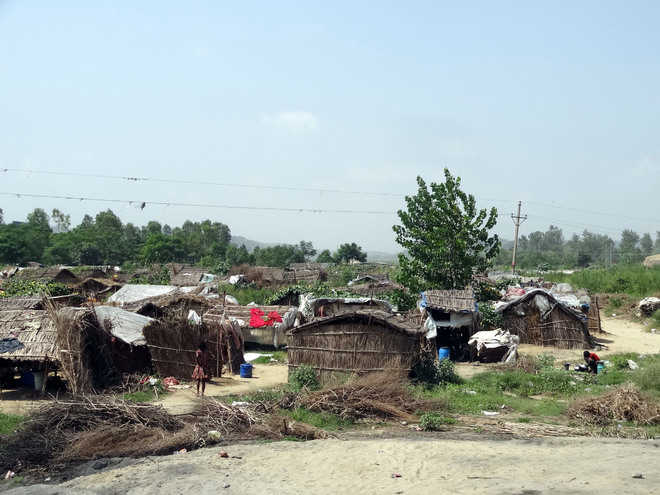Lalit Mohan
Tribune News Service
Una, December 23
The growth of industry in Tahliwal and Bathri villages of Una district has brought with it one of biggest slums of the state.
Tahliwal-Bathri is the second biggest industrial belt of Himachal after the Nalagarh-Baddi belt. The growth of industry here started in about 2003 when an industrial package was given to the state by the then NDA government led by Atal Behari Vajpayee. Today the Tahliwal and Bathri villages have hundreds of industrial units.
These hundreds of industrial units have led to development of a slum area that houses thousands of migrant labourers from Bihar and UP living in pitiable conditions without basic facilities such as drinking water or hygiene.
When a Tribune team visited the slum in Bathri only a few children were present in the huts created out straw.
Kishan Budhwa, a resident of Munger district of Bihar sitting outside his hut, said hundreds people from Munger district have come here to work as construction labourers or work in factories.
“We have come through contractors who employ us in different factories and construction sites. The slums in which we live extend up to about two kilometres at Bathri village. We do not have employment or any source of income in our parent state and so have been forced to migrate here,” he said.
A few children playing around in the slums were suffering from skin diseases.
The slums neither have any protection from rains nor have any permanent source of drinking water. The labourers were living in inhuman conditions. They are dependent on locals or the adjoining factories for drinking water.
The Himachal government has passed strict regulations against the employment of labourers in industries through contractors.
However, most of the labourers have been brought from Bihar and UP by the contract labourers. They exploit the labourers and also deny them the ESI scheme of the government under which they can get free health care and insurance cover.
The Department of Industries has failed to check this illegal practice of deployment of labourers through contractors in industries.
GM Industries Una was not available for comment despite repeated calls on his mobile phone.
As far as migrant labourers working at construction sites were concerned they were covered under the Buildings and Other Construction Workers (Regulation of Employment and Conditions of Service) Act, 1996. Under the Act, the construction workers get a health insurance cover of Rs 30,000, an accidental death insurance cover worth Rs 70,000 and maternity benefit to women construction workers worth Rs 10,000.
Besides, a pension of Rs 500 per month is given to the construction workers who are enrolled in the scheme continuously for a period of three years after attaining the age of 60. They can also get an interest-free loan of Rs 50,000 for the construction of a house.
However, none of the thousands of labourers living in the slums of village Bathri were registered under the Act.
Unlock Exclusive Insights with The Tribune Premium
Take your experience further with Premium access.
Thought-provoking Opinions, Expert Analysis, In-depth Insights and other Member Only Benefits
Already a Member? Sign In Now










